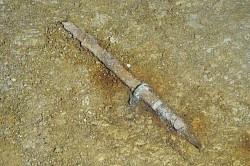Knife and accessories uncovered from mid-eighth century grave site in Ibaraki show ties to the Nara politcal centre
Source - http://heritageofjapan.wordpress.com/

An ancient knife together with metal accessories is seen after its discovery at the burial site. (Photo courtesy of the Hitachinaka Municipal Board of Education)
Knife, accessories unearthed at ancient grave site in Ibaraki (Mainichi, Feb 9, 2012)
An ancient knife and its metal accessories have been unearthed at an ancient burial site in Hitachinaka, Ibaraki Prefecture, the city’s board of education announced on Feb. 8.
The knife, measuring around 25 centimeters, resembles one kept at the Shosoin treasure house that belonged to the Todaiji Temple in Nara Prefecture. The board of education believes that it belonged to a high-ranking person with close ties to the central government.
The knife, thought to be from the mid-8th century, was found with metal parts for the top and bottom of its sheath still attached. This type of knife was originally used to shave off paper or wooden tablets, and later it was used as a symbol of authority.
In the same cave where the knife was found, early-9th century pottery, a 55-centimeter sword, four other knives, six skulls, and the cremated remains of two people have been found. Fifty-seven other items including pottery were found in an area near the grave entrance.
The grave site where the knife was found, “Jugoroana yokoana bogun,” is thought to have been used from the early 7th century to mid-9th century, and holds around 300 to 400 graves.
According to Satoru Yoshizawa, an archaeological researcher at Nara National Museum, it is rare to find a knife complete with metal accessories, as the type of grave in which it was uncovered is often plundered.
Unearthed sword suggests ancient tie (Feb.14, Yomiuri Shimbun)
A small sword unearthed at an ancient burial site in Hitachinaka, Ibaraki Prefecture, was found to resemble a precious sword stored at the Shoso-in repository in Nara, indicating the area may have had ties with the political center at the time, according to the Hitachinaka municipal board of education.
Jugoroana, the site where the sword was discovered, is one of the largest ancient graveyards in eastern Japan. It is said to have about 300 to 400 burial tunnels dug into the side of a plateau.
The site is believed to have been built from around the early eighth century up through the Heian period (794-1192).
According to the board, the sword has a metal fitting identical to that of a sword called Hansai no Tsuka Byakuge no Saya no Ontosu. That sword is one of Shoso-in’s treasures, which include many pieces associated with Emperor Shomu (701-756).
Judging from earthenware discovered near the sword, specialists believe it was made around the eighth century.
As very few high-ranking people were entitled to carry this type of sword, the board assumes the person who was buried with the sword may have had strong ties to the central government.
Experts say the sword was meant to be used as a tool to carve wooden tablets and was also worn as an ornament, hanging from a sash belt by a string.
Made from iron and 25 centimeters long, the sword was discovered during an excavation of one of the burial tunnels measuring 3.15 meters wide and 2.7 meters long. When discovered, the metal fitting was plugged into the sword.